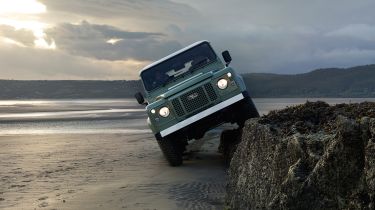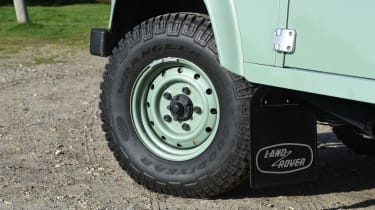Land Rover Defender SUV (1983-2016) - Engines, drive & performance
The Land Rover Defender is slow and is difficult to drive, but has greater off-road ability than almost anything else on sale
One look at any normal Land Rover Defender suggests it’s probably not going to be the most user-friendly or comfortable thing on the road. You don’t so much drive this car as manhandle it in the direction you want to go.
The Defender’s age shows up immediately when you get behind the wheel, as the steering is very inaccurate. It feels very heavy to use and requires much more input to turn than you might be used to. And when you do drive around a bend, you and your passengers will be thrown around a lot due to the Defender’s tendency to lean into any corner.
The agricultural feeling continues when you need to change gear: the clutch pedal is very heavy and the gearlever needs a hefty shove to shift cleanly.
The Defender’s poor on-road handling pales in comparison to its unbeatable grip and capability when faced with a muddy track, steep incline or a deep ford. Throw it at any form of rough terrain and the Defender will more than likely get you through, over, across or out of it with minimal fuss.
Land Rover Defender diesel engine
There’s only one diesel engine available, no matter what version of the Defender you go for – whether it’s the 90 Station Wagon or the massive 130 Double Cab Pick Up.
More reviews
The 118bhp diesel isn’t very powerful – you can get a Ford Focus with a 1.5-litre diesel engine that provides just as much oomph. However, what this engine lacks in outright power, it more than makes up for in low-rev pulling ability, or torque. This makes the Defender much better suited to towing heavy trailers or scrabbling out of thick mud than accelerating quickly.
This is borne out by a lazy 0-62mph time of 15.8 seconds, while a top speed of just 90mph means the Defender is outclassed in the performance stakes by the humble Toyota Aygo city car.
Land Rover Defender petrol engine
The Works V8 pretty much tears up the Defender rulebook. Out goes the tractor-like diesel in favour of a non-supercharged version of Jaguar Land Rover's 5.0-litre V8 petrol engine, putting 400bhp on tap. The gearbox is an eight-speed automatic and you might recognise its 'trigger' gear selector from the Jaguar F-Type.
The hard-edged, muscle-car roar couldn't be more out of character for a Defender – even the older Rover V8-powered models emitted more of a cultured rumble than the Works V8's snarling bark. It's a noise that's untroubled by much in the way of sound deadening and rather echoes around the interior. Fittingly, every other aspect of the way it drives is just as far removed from the norm, from its 5.6-second (or 5.8-second for the five-door 110) 0-62mph time to the fact that it can actually carry speed around corners.
This newfound agility comes courtesy of a complete suspension re-think, with new springs, dampers and anti-roll bars, although even these can't quite mask the huge bulk of the car and physics dictate a bit of inevitable body lean. The steering has been modified and is far less sloppy than normal for a Defender, although still rather vague and disconnected by modern standards. Remarkably, despite such big wheels and tyres, the ride is smoother than in a regular diesel Defender, too – potholes don't cause the car to shudder quite so badly.
The end result is more hilarious and exciting than it is competent. While not as deathly slow and hopelessly unwieldy as the Defender diesel, the same uncomfortable, cramped driving position remains and you'll still not want to spend much time behind the wheel. But then, like all the best toys, the Works V8 is intended more for fun than hard work.














